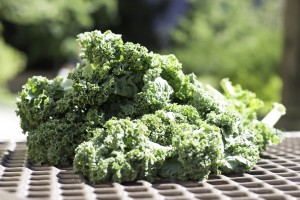
Kale is currently at center stage on the health scene, recently becoming a fad in recipes, health magazines and people’s diet changes.
Introducing kale into your diet doesn’t have to be hard, according to Kerri Bell, a registered dietician.
“Adding kale into your rotation of vegetables is easier than you think, especially as college students,” Bell said. “First, try stripping the leaves from the stem for easier eating and throw it into your morning smoothies, omelettes or using it as a base for salads. To magnify its effects even more, add in some healthy fats like olive oil or avocado to increase the absorption of the fat-soluble nutrients beta-carotene and vitamin K.”
Kale, also called borecole, is one of the healthiest vegetables in the world. A leafy green, kale comes in curly, ornamental or dinosaur varieties. It belongs to the Brassica family, the same family as cabbage, collards, broccoli and Brussels sprouts. It has outstanding health benefits, including cancer prevention and lowering of cholesterol, and is an overall vitamin and fiber powerhouse.
Kale is loaded with a high percentage of antioxidant vitamins, specifically A, C and K. Vitamin K, in particular, is necessary for a wide variety of bodily functions, including normal blood clotting and bone health.
Beyond antioxidants, the high amounts of fiber in kale bind bile acids and help lower blood cholesterol levels, which reduces the risk of heart disease, especially when kale is cooked instead of raw.
“One cup of chopped kale contains 33 calories and 9% of the daily value of calcium, 206% of vitamin A, 134% of vitamin C, and a whopping 684% of vitamin K,” said Kathleen M. Zelman, WebMD’s director of nutrition. “It is also a good source of (the) minerals copper, potassium, iron, manganese and phosphorus. These marvelous properties make kale a superstar vegetable in any kitchen.”
Kale is known to decrease the chances of cancer development.
“At the top of the cancer-related research for kale are colon cancer and breast cancer,”according to the website Whfoods.org. “The risk of bladder cancer, prostate cancer, and ovarian cancer have all been found to decrease in relationship to routine intake of kale.”
With claims like that, it is no wonder that kale has become so popular.
Kale’s cancer-preventive benefits have been clearly linked to its unusual concentration of two types of antioxidants, carotenoids and flavonoids.
In one study, researchers followed the passage of these two antioxidants in kale from the human digestive tract into the bloodstream. It was discovered that kale’s flavonoids combine both antioxidant and anti-inflammatory benefits to avoid chronic inflammation and oxidative stress, which ultimately lead to cancer.
Kale is found at most grocery stores, especially during the winter months when dark, leafy greens thrive. Look for kale that is rich in color, firm and has hardy stems. However, people are advised to ask health practitioners about a diet that fits their particular health needs.




